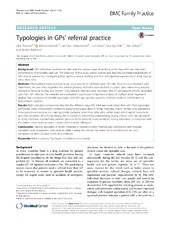| dc.contributor.author | Thorsen, Olav | en_US |
| dc.contributor.author | Hartveit, Miriam | en_US |
| dc.contributor.author | Johannessen, Jan Olav | en_US |
| dc.contributor.author | Fosse, Lars | en_US |
| dc.contributor.author | Eide, Geir Egil | en_US |
| dc.contributor.author | Schulz, Jörn | en_US |
| dc.contributor.author | Bærheim, Anders | en_US |
| dc.date.accessioned | 2016-08-11T12:47:04Z | |
| dc.date.available | 2016-08-11T12:47:04Z | |
| dc.date.issued | 2016-07-18 | |
| dc.Published | BMC Family Practice 2016, 17:76 | eng |
| dc.identifier.issn | 1471-2296 | |
| dc.identifier.uri | https://hdl.handle.net/1956/12553 | |
| dc.description.abstract | Background: GPs’ individual decisions to refer and the various ways of working when they refer are important determinants of secondary care use. The objective of this study was to explore and describe potential characteristics of GPs’ referral practice by investigating their opinions about referring and their self-reported experiences of what they do when they refer. Methods: Observational cross-sectional study using data from 128 Norwegian GPs who filled in a questionnaire with statements on how they regarded the referral process, and who were invited to collect data when they actually referred to hospital during one month. Only elective referrals were recorded. The 57 participants (44,5 %) recorded data from 691 referrals. The variables were included in a principal component analysis. A multiple linear regression analysis was conducted to identify typologies with GP’s age, gender, specialty in family medicine and location as independent variables. Results: Eight principal components describe the different ways GPs think and work when they refer. Two typologies summarize these components: confidence characterizing specialists in family medicine, mainly female, who reported a more patient-centred practice making priority decisions when they refer, who confer easily with hospital consultants and who complete the referrals during the consultation; uncertainty characterizing young, mainly male non-specialists in family medicine, experiencing patients’ pressure to be referred, heavy workload, having reluctance to cooperate with the patient and reporting sparse contact with hospital colleagues. Conclusions: Training specialists in family medicine in patient-centred method, easy conference with hospital consultant and cooperation with patients while making the referral may foster both self-reflections on own competences and increased levels of confidence. | en_US |
| dc.language.iso | eng | eng |
| dc.publisher | BioMed Central | eng |
| dc.relation.ispartof | <a href="http://hdl.handle.net/1956/15641" target="blank">General practitioners’ referrals to specialist health services. Exploring elements and factors in the referral process having an impact om patients’ access to specialty care</a> | |
| dc.rights | Attribution CC BY | eng |
| dc.rights.uri | http://creativecommons.org/licenses/by/4.0/ | eng |
| dc.subject | Referral process | eng |
| dc.subject | Typologies | eng |
| dc.subject | Confidence | eng |
| dc.subject | Uncertainty | eng |
| dc.title | Typologies in GPs’ referral practice | en_US |
| dc.type | Peer reviewed | |
| dc.type | Journal article | |
| dc.date.updated | 2016-07-18T17:04:04Z | |
| dc.description.version | publishedVersion | en_US |
| dc.rights.holder | Copyright The Author(s) | |
| dc.identifier.doi | https://doi.org/10.1186/s12875-016-0495-y | |

